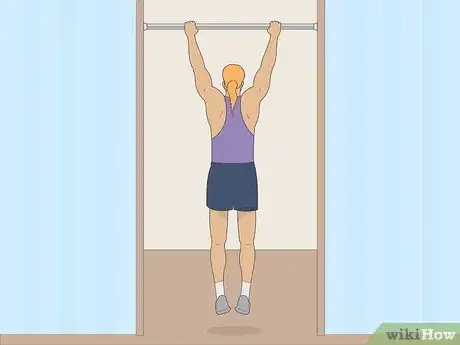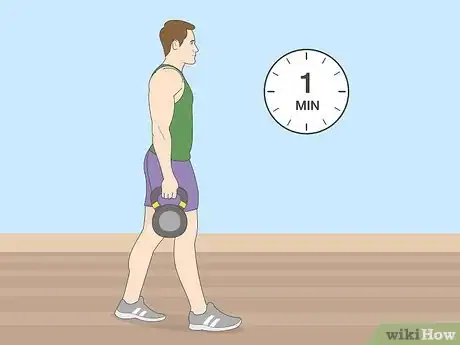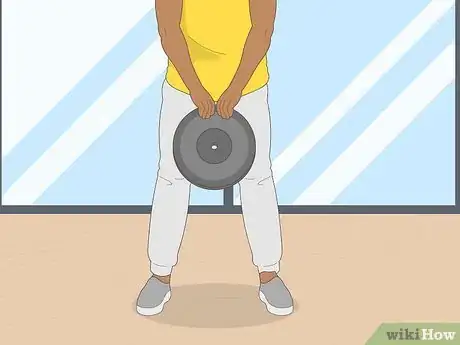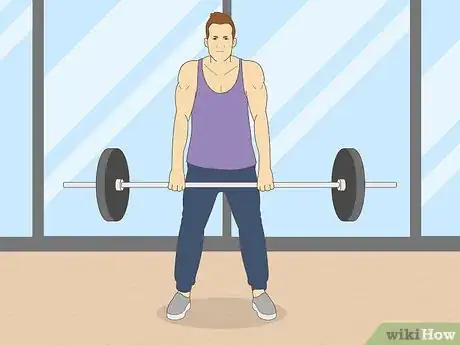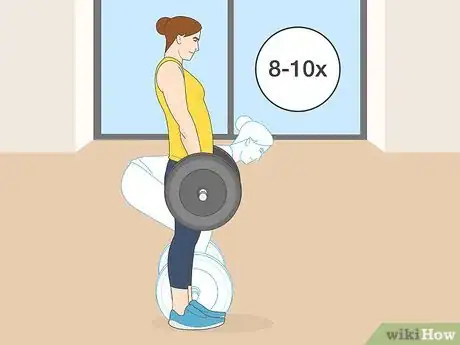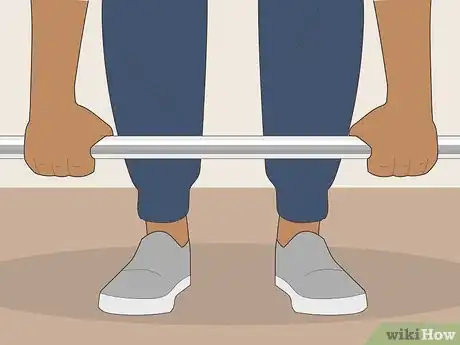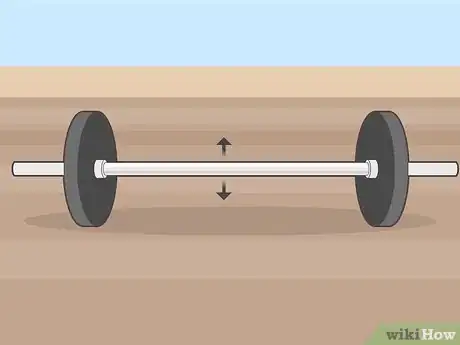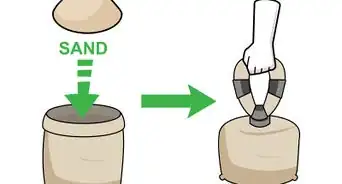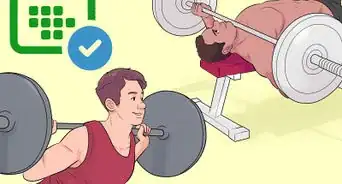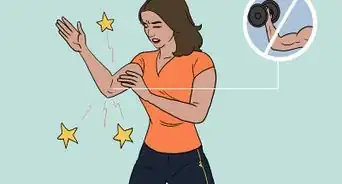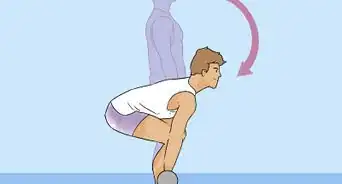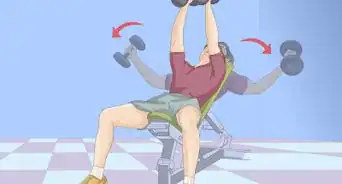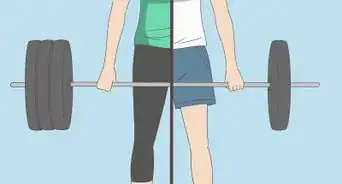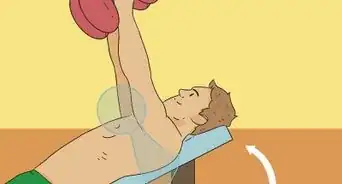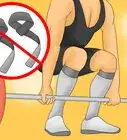This article was co-authored by Laila Ajani. Laila Ajani is a Fitness Trainer and founder of Push Personal Fitness, a personal training organization based in the San Francisco Bay Area. Laila has expertise in competitive athletics (gymnastics, powerlifting, and tennis), personal training, distance running, and Olympic lifting. Laila is certified by the National Strength & Conditioning Association (NSCA), USA Powerlifting (USAPL), and she is a Corrective Exercise Specialist (CES).
There are 7 references cited in this article, which can be found at the bottom of the page.
This article has been viewed 16,516 times.
There’s just something gritty and primal about reaching down and picking up a heavy weight. Perhaps the simplest of all the compound movements, the deadlift can also be the most challenging—and the most rewarding. It’s pretty common for lifters to struggle to hold onto the bar as they progress in weight. Luckily, you can actually improve your ability to deadlift by focusing on specific exercises and techniques that will increase your grip strength so you can get out there and pull some seriously heavy weight.
Steps
Grip Training
-
1Hang from a pullup bar for as long as you can. For a super simple grip training option, look around for a pullup bar or a bar you can hang from. Hop up and hang from the bar for as long as you can. Start by aiming for 15 seconds and try working your way up to a full minute. When you can’t hang anymore, hop down and let your grip recover for a minute or so. Then, try it again! Aim for 2-3 sets to give your grip a real challenge.[1]
- If you want to really challenge yourself, try walking your hands from side to side on the bar while you hang.
-
2Squeeze grippers as many times as you can or hold them closed. A gripper is a handheld device with 2 handles that you squeeze to workout your gripping muscles. Choose a gripper that you’re able to fully close (not one that is too tough for you to close even once) and try squeezing it shut as many times as you can.[2] Another option is to squeeze a coin between the legs of the gripper and hold it closed for as long as you can before the coin drops.[3]
- You can find grippers at sporting goods stores or order them online.
- Grippers come in different ratings, such as #1, #1.5, or #2. The higher the rating, the harder it is to close the gripper. Choose one that you’re able to fully close.
Advertisement -
3Do heavy farmer’s walks for 1 minute at a time. Find an open stretch of space where you can walk unimpeded. Grab 2 of the heaviest dumbbells you can carry, stand with your chest up and your shoulders back, and walk for as long as you can, aiming for 60 seconds. Then, set the dumbbells down and repeat the exercise as many times as you can.[4]
- Try adding 15-second increments as your grip gets better.
- You could also use heavy kettlebells instead of dumbbells.
-
4Pinch lift 2 weight plates to increase finger and grip strength. Take 2 iron weight plates, stand them up on the narrow sides, and sandwich them together so the smooth sides are facing out. Place them between your feet with the center hole facing you. Then, pinch the plates with your fingers and thumb and raise them up. Return the weights to the ground to complete 1 rep.[5]
- Start with 10 lb (4.5 kg) plates and try working your way up to 45 lb (20 kg) plates.
- Repeat the movement until you can’t pinch the plates together. You might be surprised just how zapped your grip will feel after this exercise!
-
5Use barbell shrugs to practice holding heavy weights. Load up a barbell with enough weight to challenge your grip. Stand holding the barbell using an overhand grip, which means you hold the bar with your palms facing toward your body. Space your hands about shoulder-width apart. Keep your arms straight and raise your shoulders up towards the ceiling. Pause for 3 seconds, then return the starting position. Continue performing the movement until you can’t hold the bar anymore.[6]
- Shoot for 2-3 sets of 8-10 reps to really work your grip strength.
- You can also use a trap bar (a special bar shaped like a hexagon), a pair of heavy dumbbells, or even a shrug machine to improve your grip.
-
6Try reverse barbell wrist curls to blast your forearms. Hold a barbell with an overhand grip behind you so your palms are facing out and the bar is about 2–3 inches (5.1–7.6 cm) away from your lower back. Stand up straight and tall, and allow the barbell to roll down onto your fingertips. Then, keeping your arms straight, make a fist, grip the barbell, and flex your forearms. Repeat the motion by allowing the barbell to roll back down to your fingertips.[7]
- Make sure you do the exercise slowly and with control.
- You may want to do this exercise close to a barbell rack so you can place the bar back down on it when you’re finished or can’t hold it anymore.
- Aim for 2-3 sets of 8-10 reps and use a weight that works your forearms but isn’t so heavy that you can’t hold onto it safely.
Deadlift Training
-
1Deadlift in the 8-10 rep range to focus more on your grip. Load up a barbell with weight on the floor. Stand over the barbell with your feet shoulder-width apart, grasp the bar with your hands just outside of your legs, and stand up, keeping a flat back. Lower the bar with control to complete 1 rep.[8] To specifically target your grip, use a weight you can deadlift 10 times and stick to sets in the 8-10 rep range.[9]
- Doing heavy deadlifts in the 3-4 rep range will make you strong, but it won’t challenge your grip as much as higher rep ranges.
- If you’re new to deadlifts, try working with a trainer or an experienced lifter to make sure you’ve got the form down right. Doing deadlifts incorrectly can lead to injuries.
-
2Use a double overhand grip when you deadlift. Hold the bar with an overhand grip, meaning the backs of your hands are visible and your thumb is wrapped around the bar. Use this grip as much as you can whenever you deadlift to challenge your grip.[10]
- A mixed grip is where you have 1 hand with your palm facing out and the other hand with your palm facing in. A hook grip means you don’t wrap your thumb around the bar. Both of these variations make it easier to hang onto the bar and won’t really improve your grip strength.
-
3Hold the bar 10 seconds at the top of each rep for an extra challenge. To really fire up your gripping muscles, use a double overhand grip and hold the position at the top of the lift. Grip the bar for a full 10 seconds before you lower it back down to the ground and perform another rep. Your forearms will feel like they’re on fire! But you’ll boost your grip gains.[11]
- If you feel like you can’t hold the bar anymore, lower it down with control. Try not to drop the weight from the top of the position of you could potentially injure yourself.
-
4Try using a fat bar to make the bar harder to hold. A fat bar is exactly what it sounds like—a wider barbell. A wider bar makes it much harder to grip when you deadlift. Swap out your standard barbell for a fat bar if you want to focus more on your grip.[12]
- You can also use devices such as FatGripz, which fit over a standard barbell to make it wider and more challenging for your grip.
- Use a double overhand grip with the fat bar as well to focus on training your grip.
Expert Q&A
-
QuestionShould I use lifting straps?
 Laila AjaniLaila Ajani is a Fitness Trainer and founder of Push Personal Fitness, a personal training organization based in the San Francisco Bay Area. Laila has expertise in competitive athletics (gymnastics, powerlifting, and tennis), personal training, distance running, and Olympic lifting. Laila is certified by the National Strength & Conditioning Association (NSCA), USA Powerlifting (USAPL), and she is a Corrective Exercise Specialist (CES).
Laila AjaniLaila Ajani is a Fitness Trainer and founder of Push Personal Fitness, a personal training organization based in the San Francisco Bay Area. Laila has expertise in competitive athletics (gymnastics, powerlifting, and tennis), personal training, distance running, and Olympic lifting. Laila is certified by the National Strength & Conditioning Association (NSCA), USA Powerlifting (USAPL), and she is a Corrective Exercise Specialist (CES).
Fitness Trainer When it comes to lifting straps, if your main goal is to sort of take the grip component out of the exercise so you can just focus on the rest of your form. If your goal is to strengthen your grip, I wouldn't recommend using them.
When it comes to lifting straps, if your main goal is to sort of take the grip component out of the exercise so you can just focus on the rest of your form. If your goal is to strengthen your grip, I wouldn't recommend using them. -
QuestionHow can I get better at the Romanian deadlift?
 Laila AjaniLaila Ajani is a Fitness Trainer and founder of Push Personal Fitness, a personal training organization based in the San Francisco Bay Area. Laila has expertise in competitive athletics (gymnastics, powerlifting, and tennis), personal training, distance running, and Olympic lifting. Laila is certified by the National Strength & Conditioning Association (NSCA), USA Powerlifting (USAPL), and she is a Corrective Exercise Specialist (CES).
Laila AjaniLaila Ajani is a Fitness Trainer and founder of Push Personal Fitness, a personal training organization based in the San Francisco Bay Area. Laila has expertise in competitive athletics (gymnastics, powerlifting, and tennis), personal training, distance running, and Olympic lifting. Laila is certified by the National Strength & Conditioning Association (NSCA), USA Powerlifting (USAPL), and she is a Corrective Exercise Specialist (CES).
Fitness Trainer You really want to improve the flexibility of your hamstrings; that's the key part of getting the right depth and curve in your back with the Romanian deadlift.
You really want to improve the flexibility of your hamstrings; that's the key part of getting the right depth and curve in your back with the Romanian deadlift. -
QuestionWhat part of your body does the deadlift engage?
 Laila AjaniLaila Ajani is a Fitness Trainer and founder of Push Personal Fitness, a personal training organization based in the San Francisco Bay Area. Laila has expertise in competitive athletics (gymnastics, powerlifting, and tennis), personal training, distance running, and Olympic lifting. Laila is certified by the National Strength & Conditioning Association (NSCA), USA Powerlifting (USAPL), and she is a Corrective Exercise Specialist (CES).
Laila AjaniLaila Ajani is a Fitness Trainer and founder of Push Personal Fitness, a personal training organization based in the San Francisco Bay Area. Laila has expertise in competitive athletics (gymnastics, powerlifting, and tennis), personal training, distance running, and Olympic lifting. Laila is certified by the National Strength & Conditioning Association (NSCA), USA Powerlifting (USAPL), and she is a Corrective Exercise Specialist (CES).
Fitness Trainer The deadlift is a phenomenal way to improve the strength of your glutes. Honestly, they're a good exercise for your entire body, though. You definitely engage every part of your body when you do this exercise, and it's a great "bang for your buck" option if you want to incorporate it into your routine.
The deadlift is a phenomenal way to improve the strength of your glutes. Honestly, they're a good exercise for your entire body, though. You definitely engage every part of your body when you do this exercise, and it's a great "bang for your buck" option if you want to incorporate it into your routine.
Warnings
- Deadlifts can be dangerous if they’re performed incorrectly. Make sure you use good form for every rep and consider working with a trainer or an experienced lifter to help learn the form if you’re a beginner.⧼thumbs_response⧽
References
- ↑ https://medium.com/@Mark_Barroso/8-exercises-for-incredible-grip-strength-a44d05bca432
- ↑ https://www.kingofthegym.com/grip-strength-training/
- ↑ http://jasonferruggia.com/mythbusting-improve-grip-strength-deadlifting/
- ↑ https://www.mensjournal.com/health-fitness/want-to-lift-more-start-with-your-grip-strength-20151120/
- ↑ https://www.kingofthegym.com/grip-strength-training/
- ↑ https://medium.com/@Mark_Barroso/8-exercises-for-incredible-grip-strength-a44d05bca432
- ↑ https://medium.com/@Mark_Barroso/8-exercises-for-incredible-grip-strength-a44d05bca432
- ↑ https://www.coachmag.co.uk/barbell-exercises/3725/how-to-deadlift
- ↑ https://medium.com/@Mark_Barroso/8-exercises-for-incredible-grip-strength-a44d05bca432
- ↑ https://www.mensjournal.com/health-fitness/want-to-lift-more-start-with-your-grip-strength-20151120/
- ↑ https://powerliftingtechnique.com/how-to-maximize-your-deadlift-grip/
- ↑ https://www.t-nation.com/training/grip-training-for-the-deadlift
- ↑ https://www.mensjournal.com/health-fitness/want-to-lift-more-start-with-your-grip-strength-20151120/
